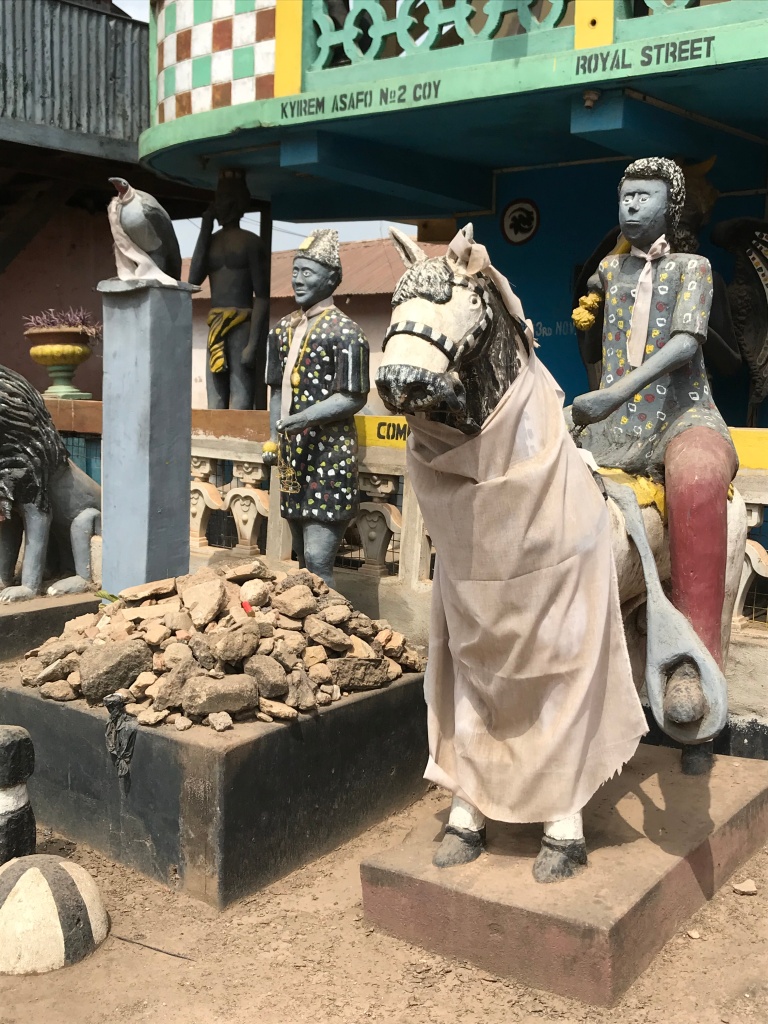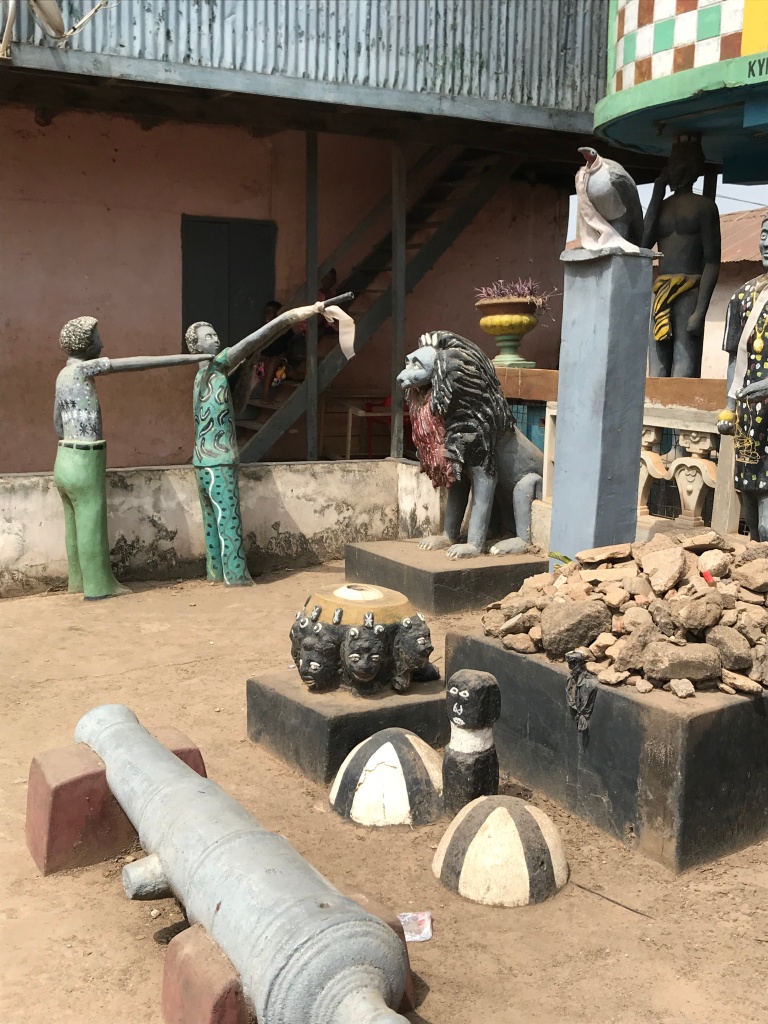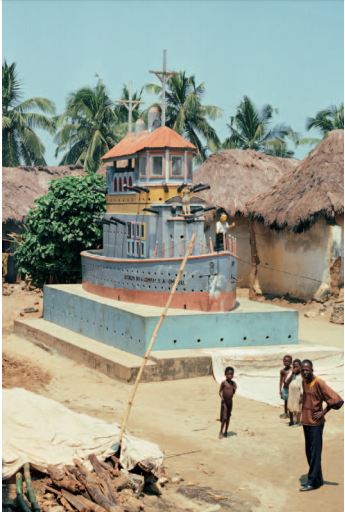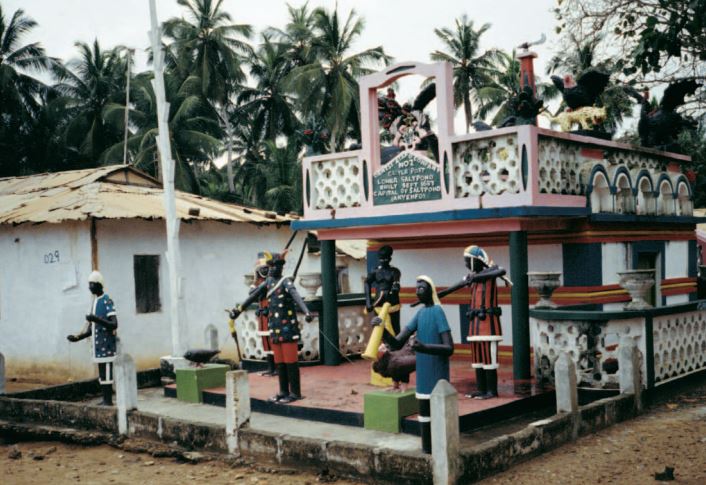In January we made a trip to Elmina area to show our visiting American family the coastal portion of the central region of Ghana which is very interesting from a historical perspective and also offers a fabulous beach break. We stayed at the wonderful Ko-Sa resort and were welcomed by the the owners Noel and Annelies, who showed us to our resting places for the weekend.
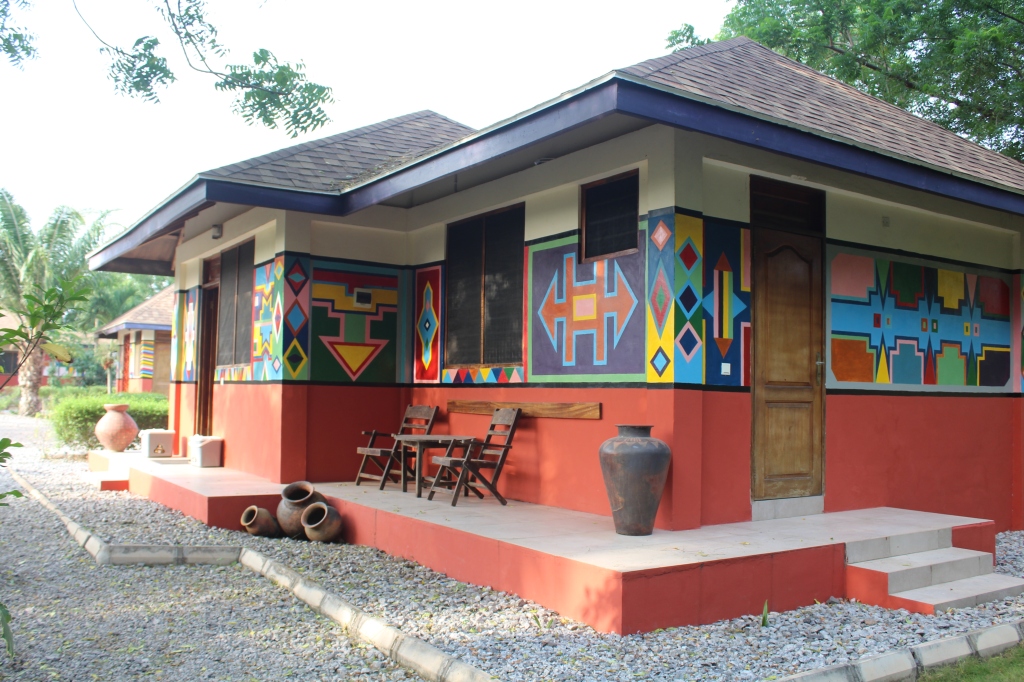
On the way to our rooms I glanced down at the brochure that Noel has handed me, which mentions things to do in the area. The words ‘Posuban shrines’ caught my eye, I don’t know this ‘Posuban’ word….and as our human brains so interestingly do, in those seconds mine latches onto a similar word I know: ‘Possum’. It is likely that this was top of mind as lots of reminiscing has been taking place with our American guests in the last few days, as twenty years prior I had lived with Lynn and her husband Rocky in Texas for six months and there was a Possum who had happily taken up residence in their garage! It was very cute and for those of you who don’t know what this animal is, it is cat sized mammal with a scaly tail and a pointed snout and is native to America, Canada and Mexico.
My curiosity has me later Googling ‘Posuban’ and when this picture appears on a website from the University of Iowa, in an essay entitled ‘Military Arts of the Fante’ by Doran H Ross, I admit that it stirs something in me.
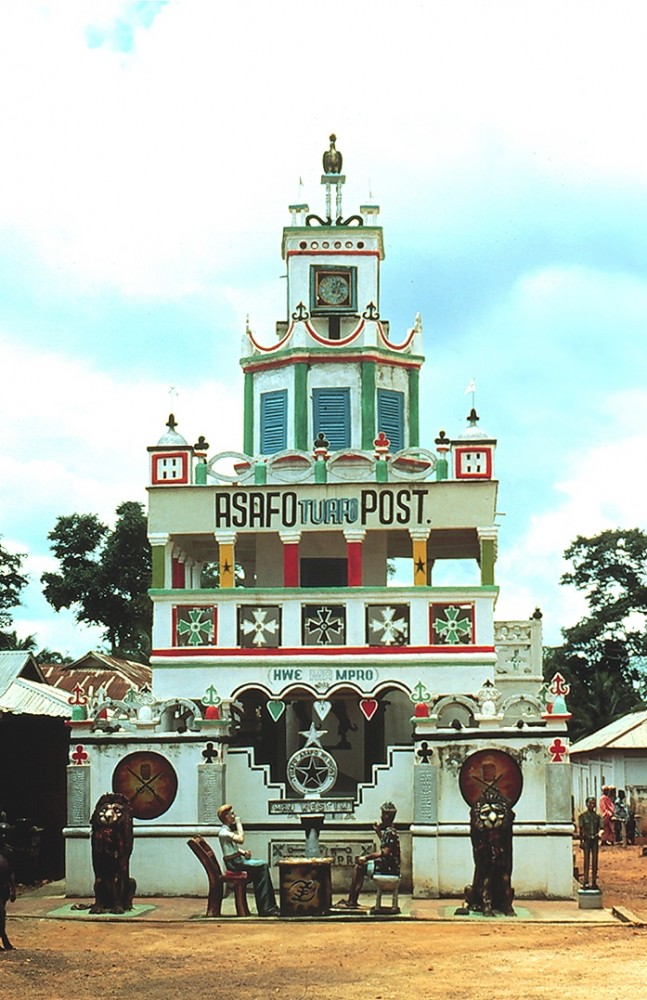
It is the delightful mix of bright red, yellow and turquoise colours, shapes and patterns that look like those on playing cards, hearts dangling off balconies that remind me of traditional Scandinavian Christmas ornaments and a blonde man sitting drinking tea at a table with an African man that could be a comic block from a Tin Tin adventure book – these things have me somewhat mesmerized at the photo on my screen. Am I looking at a beautifully illustrated page of a children’s story book or an actual place in Ghana? And how on earth does such an eccentric looking place fit into the culture and history of this country?
Posuban shrines in Elmina
As I read on, pennies drop that I have in fact seen some of these shrines previously in Elmina, on a walking tour that I had done with some friends last year. The day before that tour we had attended the spectacular local Bakatue Festival with Jolinaiko Tours, which is celebrated annually in Elmina in July. However, I can’t recall hearing the unusual official name for these shrines and didn’t pay much attention to them at the time. But this doesn’t surprise me as the sensory explosion of that festival was unlike anything I had ever experienced, and my whole being was so filled to the brim with the incredible sights and sounds of the day before, and my mind was still very much trying to process all the wondrous things it had been privy to! (to read my blog post on the Bakatue festival in a new tab click here).
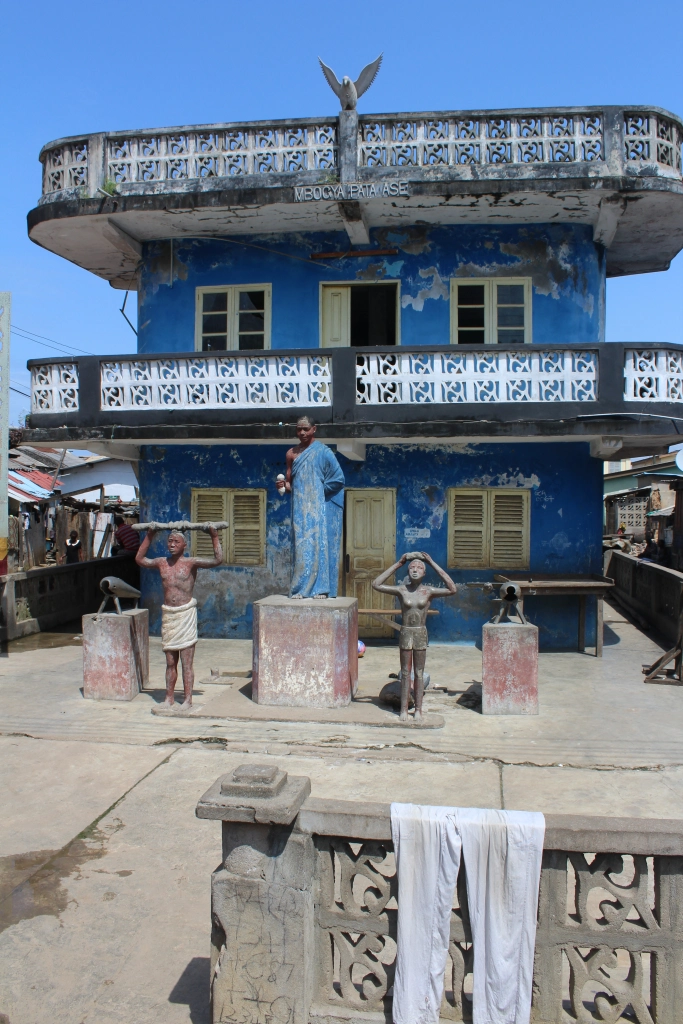
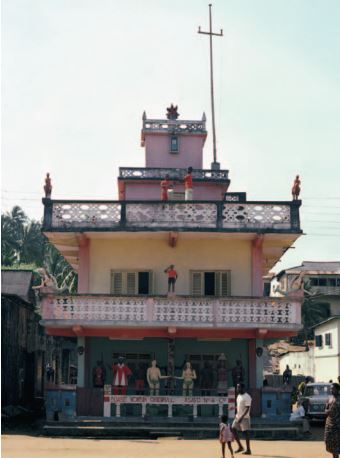
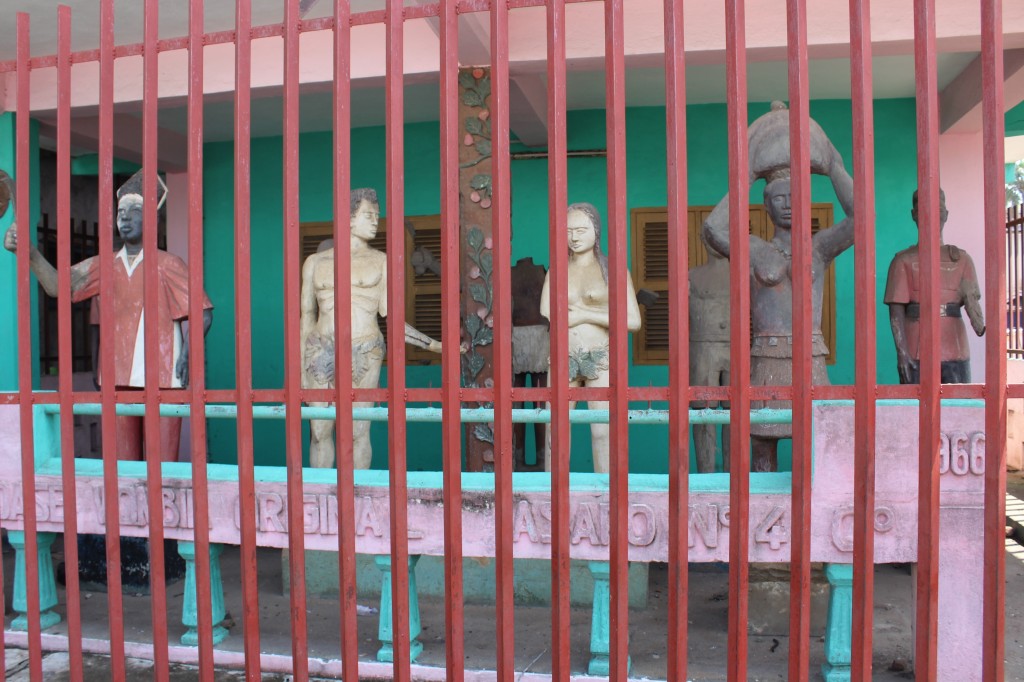
Later feeling the warm coarse beach sand under my feet and my cell phone in my hand, I find it most interesting to learn about how the Posuban shrines fit into the Ghanaian cultural landscape.
When the Portuguese arrived here in the 15th century and claimed the Gold Coast that was later taken over by the Dutch, and then the British, they built the imposing forts and castles that still exist along the coast of Ghana, and they traded gold, ivory and slaves with the local people who lived in the interior of the land. Complicated commercial alliances were formed between the Colonists and the people of the Gold Coast.
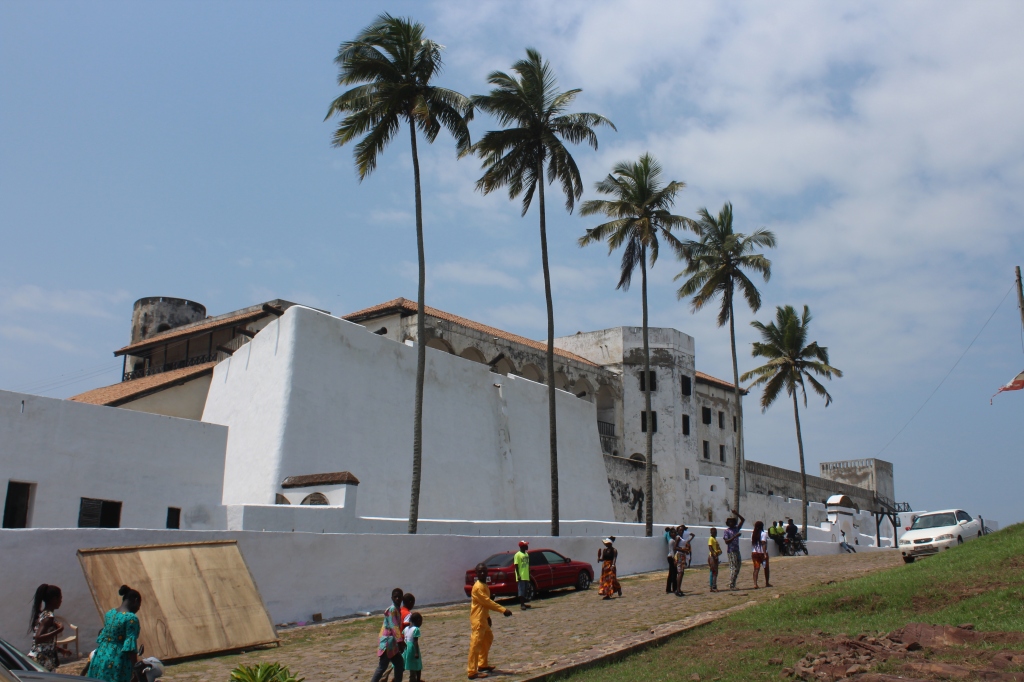
The Fante people are a subgroup of the Akan people who inhabit the central coastal region. During the colonial period they managed to keep their kingdom intact by being the middlemen and intermediaries between the Colonists and the locals with matters of trade.
What makes me fascinated to learn about the history of the Fante people through these interesting architectural forms, is that so often as expats living in Ghana, the history that we learn about is when we visit the castles or forts and we hear of the atrocities that went on for centuries and how slaves were held in the dark cramped dungeons below and treated in the most inhumane, shocking manner before being sent off to sea to work in other ‘new lands’. This is most interesting (and heartbreaking) don’t get me wrong, but we don’t often hear about other other angles of local history and some of the ‘in between’ during the 486 years that this part of Africa was ruled by Europeans.
The Asafo Companies and Fante flags
Back in the 18th century, the Fante people of Ghana formed traditional military groups called ‘Asafo companies’ among themselves. The word ‘Asafo’ come from two Akan words and means ‘warriors of war’. These companies had the task of defending the Akan states and cities, providing security services to the community and playing a role in local politics. The companies were organised into rank order with each having a number and were called by their number followed by the town or state they represented. (ie. No. 4, Elmina). The companies were rivals to each other, and each company believed itself to be the best warrior group!
They would parade with handmade appliqued flag banners at festivals claiming their unique strength and power. These flags are the most well-known visual art form of the Asafo companies, and secondary are the Posuban shrines. Over time the companies lost their military role and nowadays have important social, civic and ceremonial roles in their local communities including funeral ceremonies for members, participation in annual festivals and guardianship of local deities.
When Felix from Ghana Eco Tours in Elmina took us around on our walking tour, we had a special experience of visiting an elderly man’s home to see some of the ancient flag banners of the No. 4 Company. These old relics were shown to us on the balcony of this man’s humble home, and it was a poignant time listening to him passionately explain in detail the symbolism behind each appliqued element. He would tell us all about the flag in his local language and Felix would then translate into English for us. They are beautiful works of art and each one tells a story and holds a great deal of Ghanaian history.
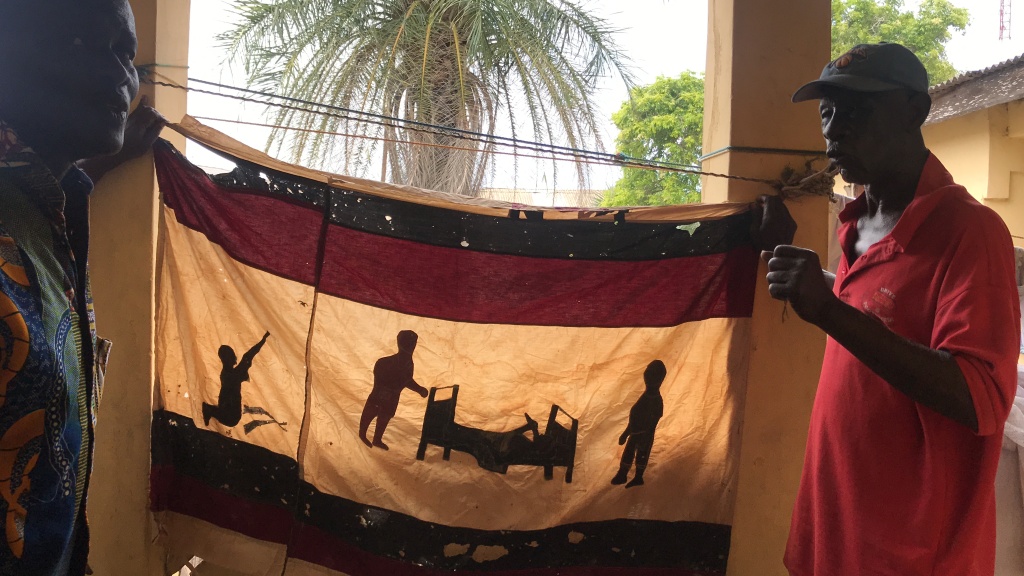

The view from the balcony 
Bella and I sitting on the balcony for the flag viewing 

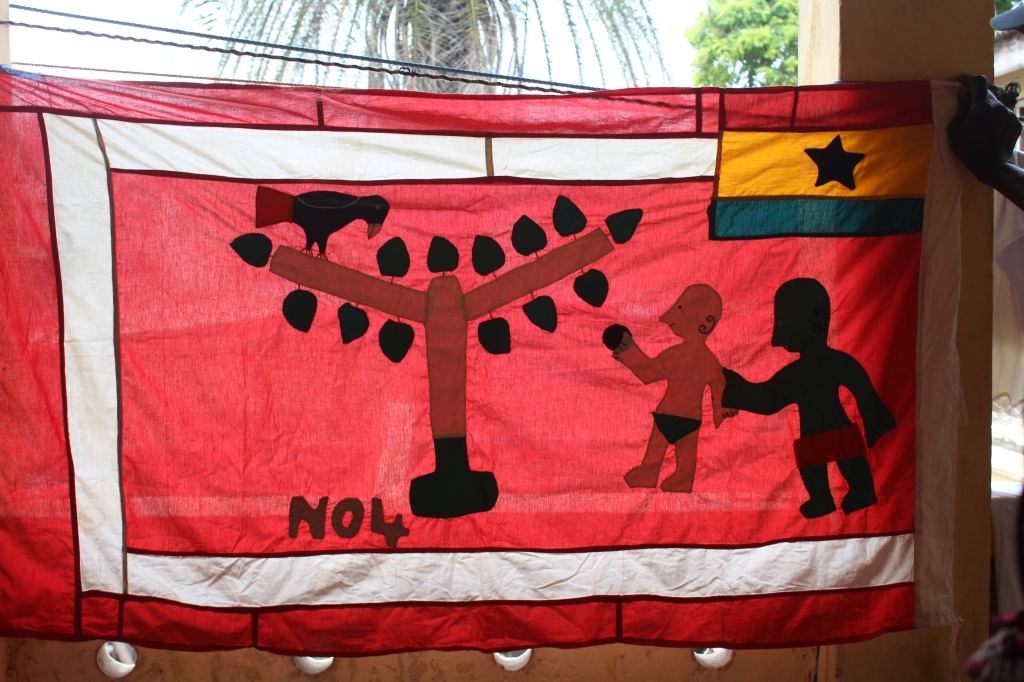
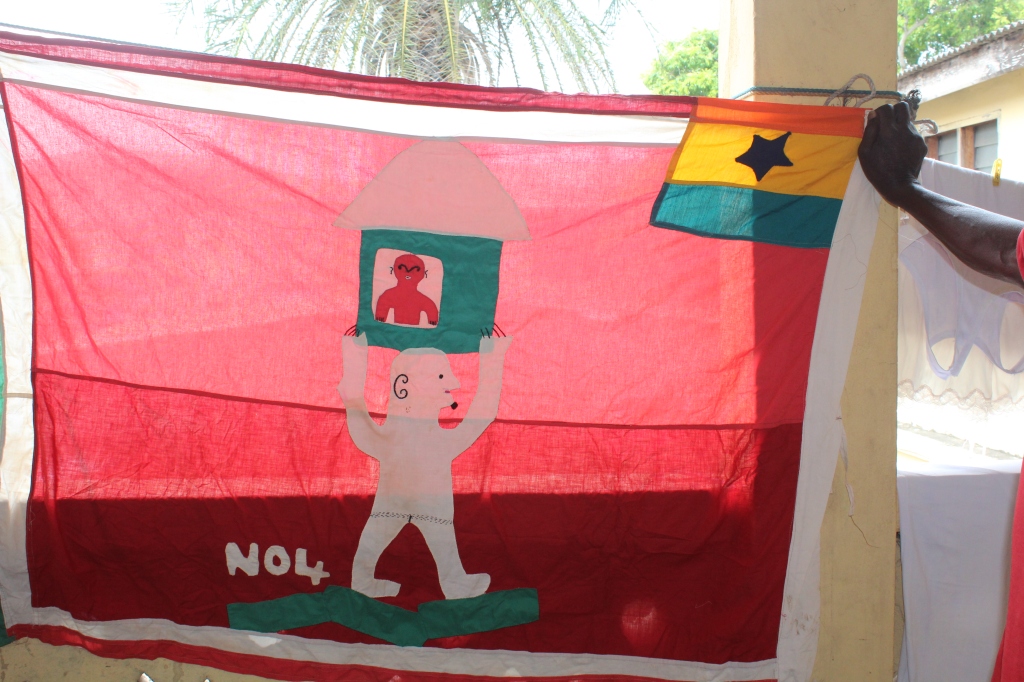



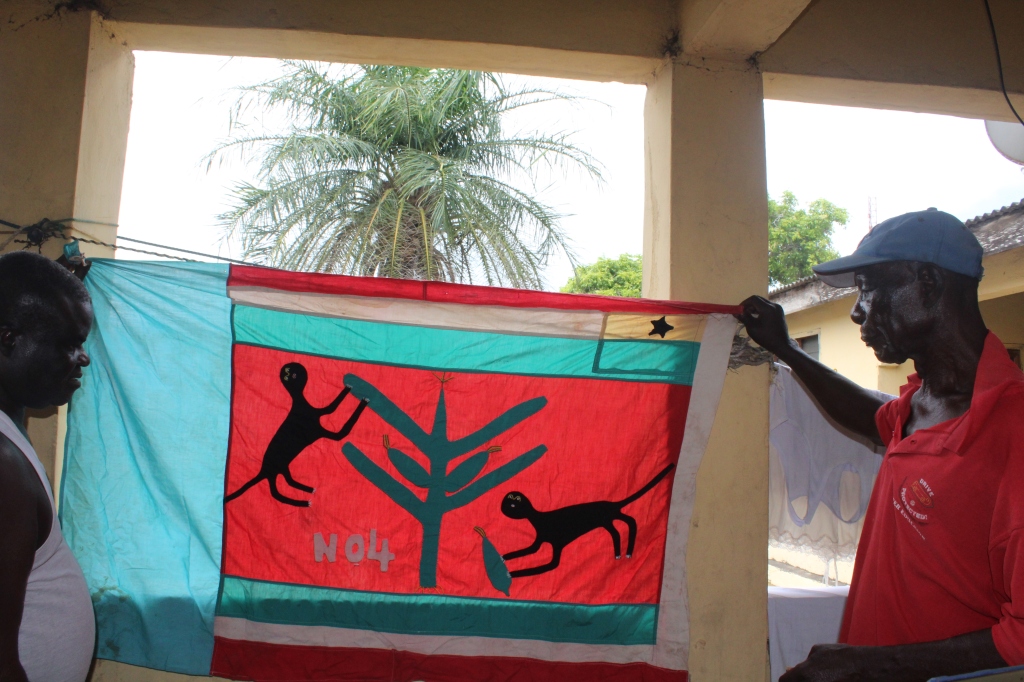

Fante flags are usually made of mill-woven cotton and sometimes silk. The figures used on the flag are cut out by hand or using a cardboard template and then sewn onto the cloth. Often the British flag appears in the corner and British naval colours were also used for the backgrounds, this was done in the hope that by imitating the British, their immense power would rub off onto the Fante people. The pictures on the flags all mean something and usually depict the superiority of one company over another through the images of animals, humans and elements of nature.

Photo Credit: Ghana Pride of Africa Culture 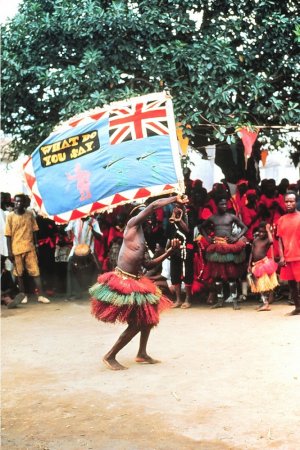
Photo Credit: Doran Ross
The Posuban of Mankessim
Back to January at Ko Sa beach resort listening to the waves crashing against the rocks, my ‘Posuban’ curiosity internet search tells me that there is one of these large Asafo company shrines in the town of Mankessim and after some more investigation it appears that it is close to the turning circle that we pass through on our way to Elmina. We are familiar with this circle as it has become known in our family as the place of the ‘sad dolphin’ because in the middle, there is a dolphin statue with a most dreary turned down smile.
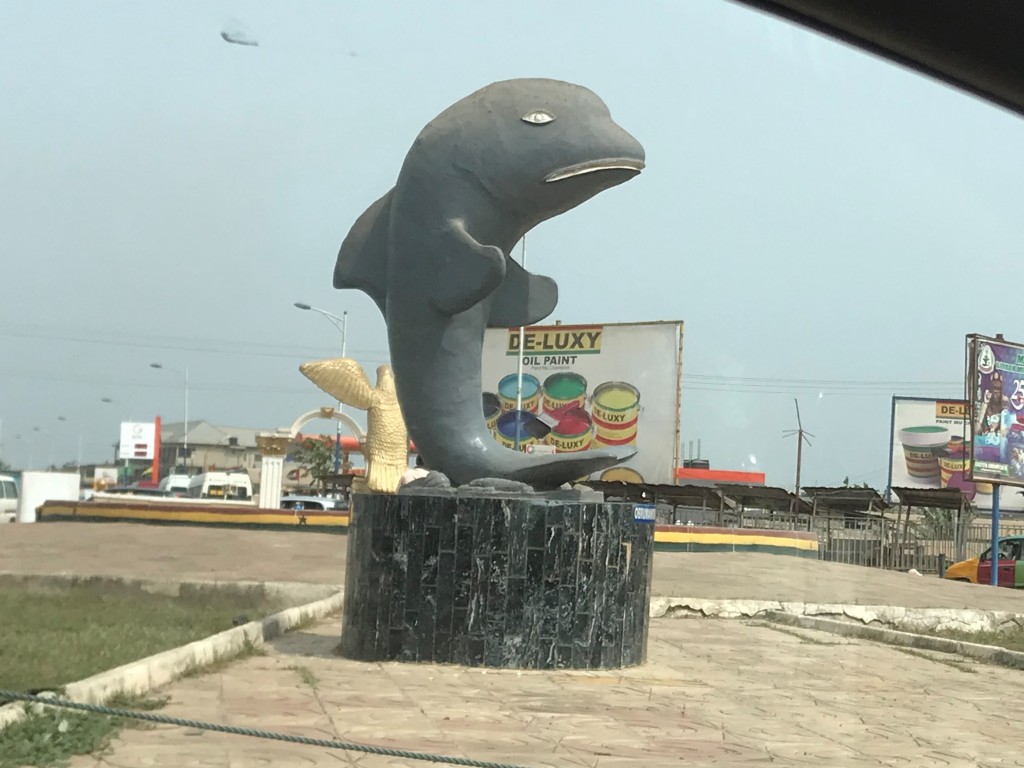
To our children the sad dolphin signals that an ice cream stop is close by at the nearby Melcom grocery store! Finding places in Ghana is unusual at the best of times. Often it is not the street name that matters, but rather a landmark near it that counts and no Uber ride request is ever complete without pointing out what place your stop is close to. I feel a little detective thrill about being able to find this unusual looking ‘Posuban’, and have a longing to see it.
My husband kindly agrees that we can try to find the Posuban in Mankessim and I’m most grateful for his willingness to oblige to these strange stops I’m often asking for. When our relaxing weekend comes to an end, we hit the road in the hope that the traffic is kind for the 3 – 4 hour journey on the single lane roads back to Accra, and once we are close to the turning circle (which includes elaborate gold sculptures) we stop to ask some men walking if they know where the shrine is. One of the men starts explaining and then tell us it will be better if he can rather show us where it is, so into our car he jumps and he shows us which exit to take and we enter a typical road of a town here – crowded full of pedestrians and cars and people selling all sorts of items on the pavements.
Within a few metres in an unassuming Ghana road with characteristic Neopolitan ice-cream coloured painted buildings, sandy sidewalks and chickens and goats scrounging around for food scraps, we see the shrine on the right hand side and this three storey structure definitely stands out with its unusual sculptured figures and bizarre looking animals.
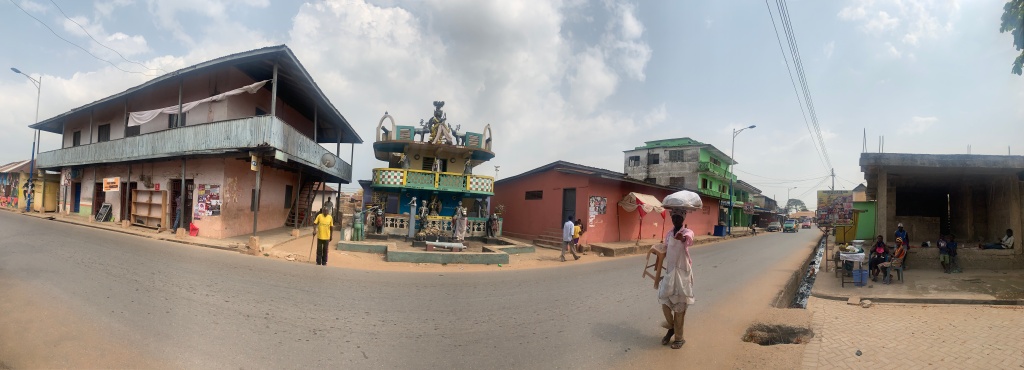
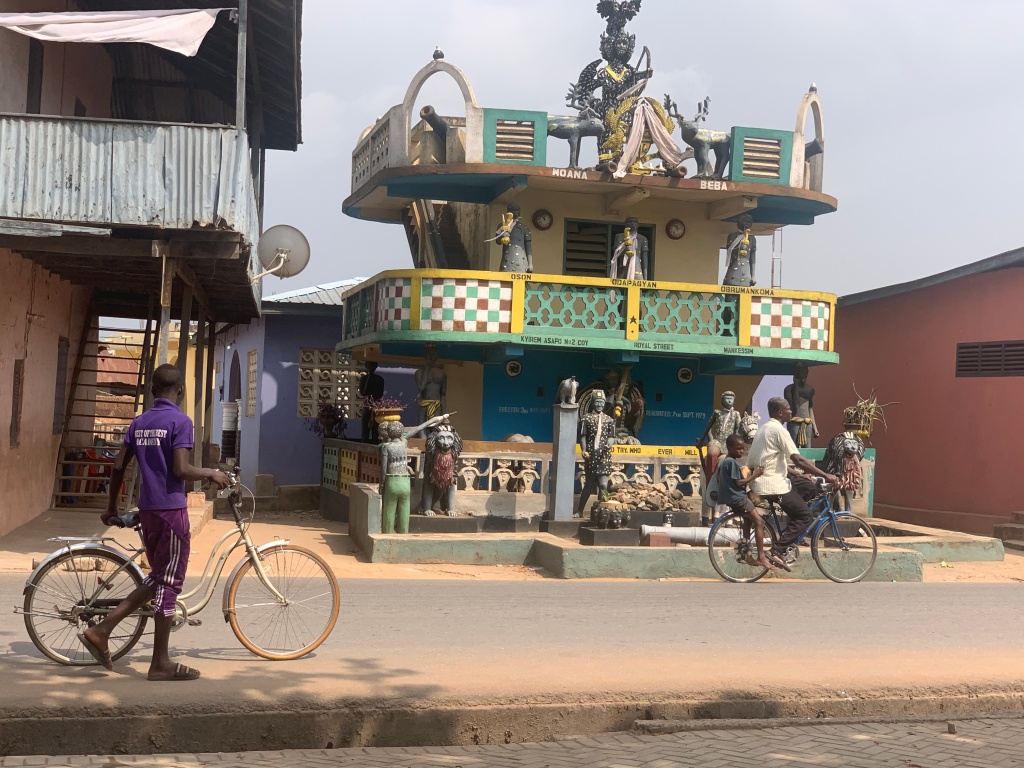
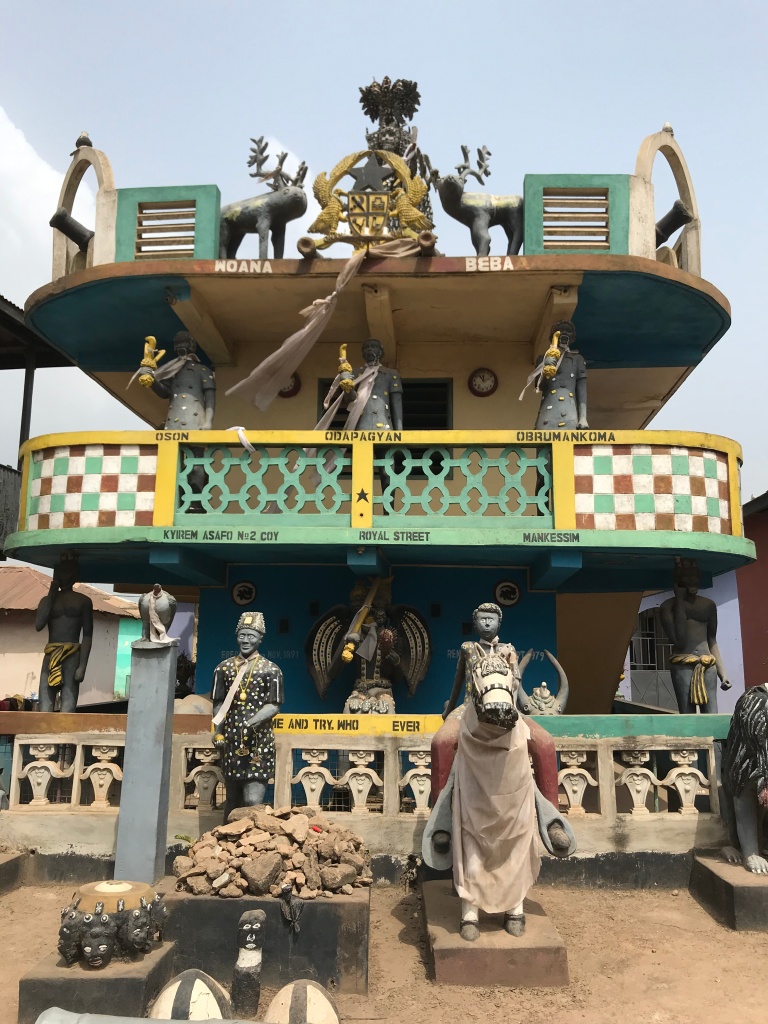
Doran H. Ross is a former director of the Fowler Museum at the University of California and has studied African arts, textiles and culture extensively. From 1974 – 2006 he documented more than seventy monumental posuban in the Central Region of Ghana! Much of the information in my post below is from an essay that he published in 2007 entitled ‘Come and Try’ – Towards a History of Fante Military Shrines’ and the information in quote marks is directly from this piece. There are also many more photos of different Posuban in his essay which are great to look at. He accurately captures what I have been thinking upon seeing photos of these shrines and now this one in front of us; “These have frequently caught the attention of visitors to Ghana largely due to their perceived playfulness and to what is assumed to be their totally incongruous presence in the Ghanaian architectural milieu.”
A smaller Posuban in Cape Coast Town
He explains further that “A Posuban may be materially defined by something as simple as a cane-fenced tree and/or a sacred mound of rock designating a god, typically covered with the shell of a giant marine turtle.” Reading this makes me think back to a walking tour of Cape Coast town that we did on the same beach stay. Only remembering to ask about Posuban once our walk was over, I queried with our tour guide whether there were any shrines nearby and he told us there was one near the Melcom shop. So our friend Jason and myself set off in the sweltering heat to find this shrine. We ended up asking four others along the way where it was when nothing was jumping out at us. “Carry on, Carry on” each person told us indicating with their hands that we must continue walking. Having no clue what to expect or what we were actually looking for, eventually in this snippet of what felt like the Amazing Race in an unfamiliar town, we stumbled upon 3 large turtle shells stacked up on each other with a rooster painted on the wall in the colours of the Ghana flag and the compass directions painted around it.
To be honest it was a little underwhelming compared to the large shrines with life size human figures that I now knew to be Posuban, but reading Ross’ essay I better understand that the Posuban include less elaborate but still meaningful shrines, like this one. Ross explains that with this type of shrine the turtle shell is providing protection for the gods. He was also told by an elder that “Sea turtle is god’s cover because you have big meat inside a sea turtle” referring to the gods immense power.
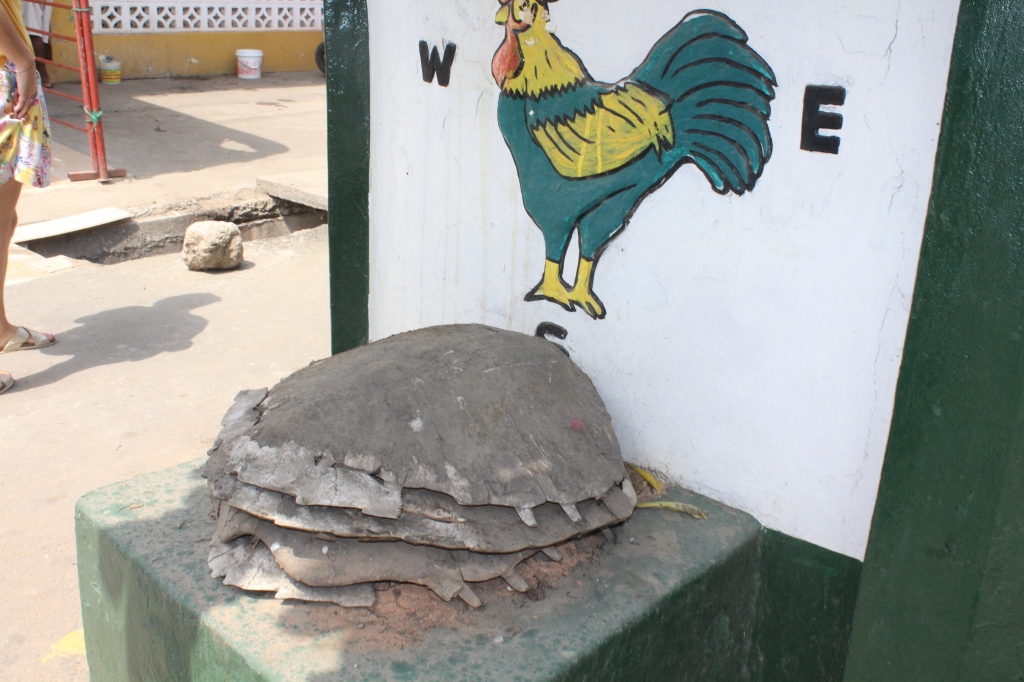
The purpose of the Monumental Posuban and the meaning behind the sculptures on them
In 1872 when the British took possession of the Gold Coast from the Dutch, Ross tells of how “there was a scramble for recognition by the British on a par with those already in the orbit of the British. In an early African initiative for self-determination, the Fante Confederation of 1868 – 72 led by key chiefs in the area, also contributed to a jockeying for power along the central coast. In this critical period of transition the asafo were caught between the long standing prerogatives of chieftaincy and newly minted colonial authority while simultaneously being deprived of their military roles. It seems to me that this was a time when the asafo needed to assert themselves and distinctive political architecture was one means to that end.”
The larger, monumental Posuban shrines like the one we stop at in Mankessim are multi-functional. They are used as storage areas for sacred company instruments, flags and regalia, they are the home of at least one of the company’s gods and are a site for ritual sacrifices and offerings. They are also the locus for company activities such as meetings, funerals, festival celebrations and gatherings and member initiations, and always include a flag post from which the Company flag can be flown. Ross explains that many of the monumental posuban include inscriptions on their facades and these have the name and number of the company, and the town in which it is located as well as the date in which is was originally revealed to the public for the first time.
When I saw the shrine in Mankessim, I was amazed to notice that it was erected in 1891 but interestingly Ross explains that the shrine in the photo below is the original one that was built in Mankessim then, but this one was removed in 1973 and the existing shrine was built, completed and revealed in the same place to the public in 1979. Oftentimes the renovations of the shrines are in fact total reconstructions as is the case here, but the date still refers to the original structure.
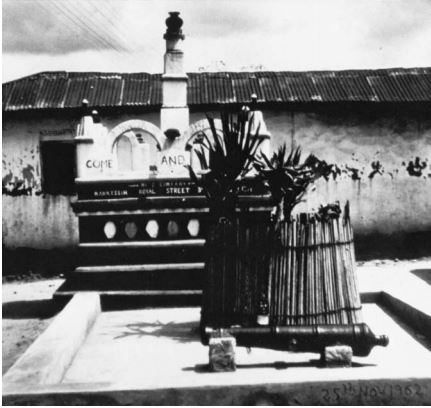
At the shrine we receive a printed hand out from an elderly gentleman explaining what some of the sculptures of the Posuban mean. We stand under the shade of the tree and he begins to recite the pamphlet word for word but as we are a little pressed for time and are trying to also sort out an unfortunate flat tyre so we give him a donation for the pamphlets and read the information on our own once we are back on the road.
Ross goes into the symbolism behind each sculpture of this shrine in great detail in his essay from pages 23 – 29, if you would like to read about what each person and animal means. Most of the images refer in some way to the power, “preparedness and diligence” of the Asafo No. 2 Company and this is emphasised in the provoking challenge on the façade of the Posuban “Come and Try Who Ever Will.” For example the ‘all seeing’ winged, seven headed creature on the top story with a bow and arrow is said to be protecting the shrine and the whole country, with the Ghanaian coat of arms in front of him.
The architect/artist Kweku Attah, who was born in 1902, built this Posuban with a mason as well as other manual labourers supplied by the Asafo company. Ross points out that the antlered animals next to the god at the top, look nothing like animals that exist in Africa, which is very obvious at first glance! But he was told by the artist that they were ‘buffaloes’ or ‘bongo antelopes’ and their symbolic meaning rests with the powerful and elusive ways of these African animals. However, the source was an image of a European deer from the book Le Monde des Animaux which explains why they look so foreign!
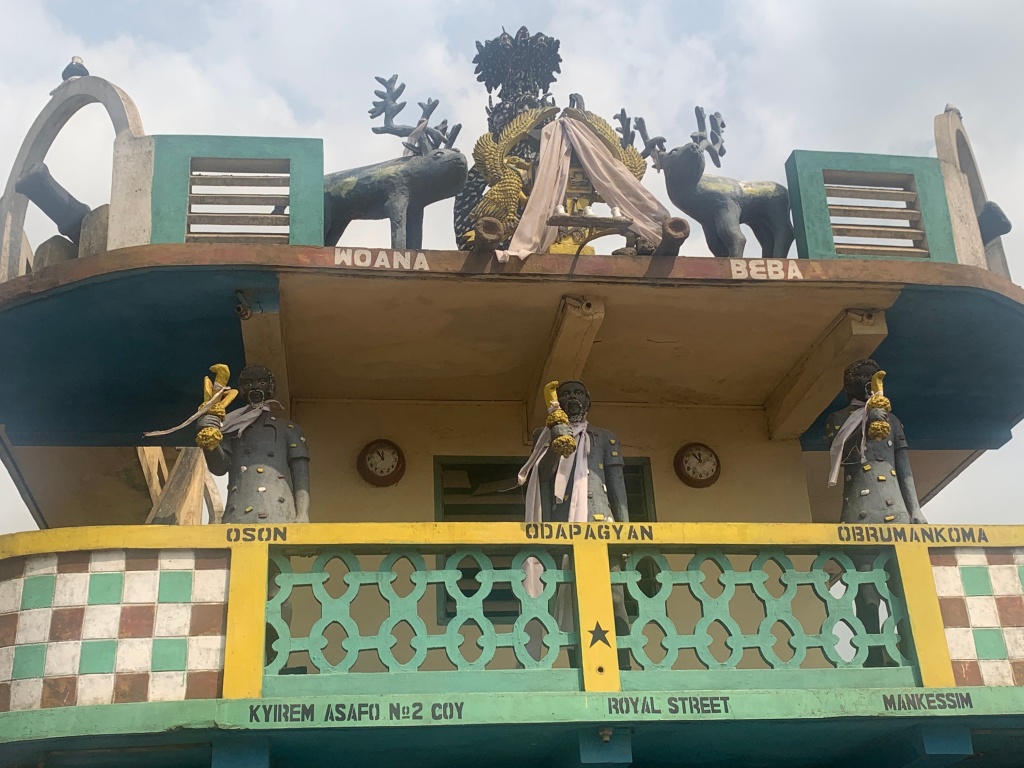

Ross sums up what I feel upon seeing the No. 2 Posuban at Mankessim “The dramatic massing of such a variety of images from so many different sources often strikes the casual viewer of this and other of the larger shrines as a somewhat peculiar, if not aberrant statement of African expressive culture. But the vast majority of these motifs are deeply rooted in Fante orature, which includes proverbs, folktales, and historical narratives, along with ancient riddles, jokes, praises, boasts and insults.”
He comments on how as new Posuban are built, or when the older ones are renovated, they will absorb influence from their current urban environments. At the time of writing the essay in 2007, he remarks on how he hadn’t seen a cell phone on a shrine yet, and I’m wondering if this has changed 13 years later!?
The Architectural roots of Posuban
Ross’ research indicates that the oldest monumental Posuban dates back to 1883 in Abandze and this was followed by the original shrine in Mankessim in 1891. Two story posuban were introduced in 1941 and the first of three story posuban appeared in 1955.
When looking at the architectural basis for the design of the posuban, it has been suggested over the years that the Fante were looking at the castles and forts that were erected by the Colonists and replicating this style of buildings especially as the most common sculptural motif found on them are cement cannons and cannon balls.
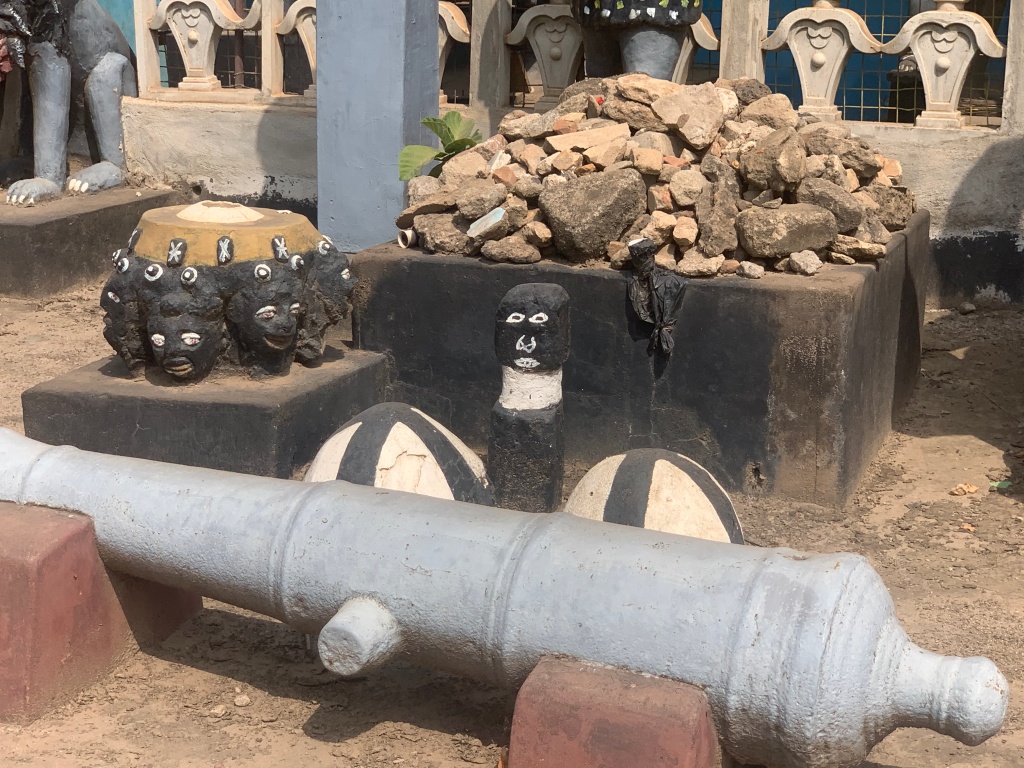
Ross writes of a man called William Bosman who spent 14 years on the Gold Coast until 1702. Speaking of a drawing of Cape Coast town Bosman tells of an English Mulatto (a mulatto was a person of mixed white and black ancestry) called Edward Barter who lived in a house under the English fort that was “not unlike a small Fort” so it has also been suggested that this type of house is what the Posuban could be modelled on.
Other suggestions are that they are based on the elaborate grave sites that have been written about in the 1600s and mausoleums which were described by de Marees in 1602 “They [the locals] are accustomed to decorate these with a large number of clay busts representing men and women, designed in a fairly jolly manner. These busts are painted in various colours and garnished all over with coral and fetishes….All around them were several pots of palm wine and meat, together with leaves and branches of fetish trees.” Church building traditions are also said to have influenced a lot of the structural details of the Posuban.
The artists who designed the Posuban
Seven artists were responsible for the creation of fifty of the monumental posuban that Ross has studied and six of these men were still alive in 1976. Five claimed to be self-taught and one of the men A. A. Mills said he had trained under his father. There are many instances of collaboration between these men and Mills claims the other artists were all ‘his boys.’
These are some of the other Posuban that Ross has photographed and researched around Ghana.
I hope that you have enjoyed learning a bit of additional Ghanaian history with me through Ross’ extensive knowledge on these fascinating structures. If you have the opportunity to visit Elmina and the Cape Coast I would really encourage you to do a walking tour of these towns with Ghana Eco Tours. There are many fascinating landmarks, buildings and snippets of local life that are simply wonderful to discover and explore on foot!
You may find my other blog posts on the following pages useful:



